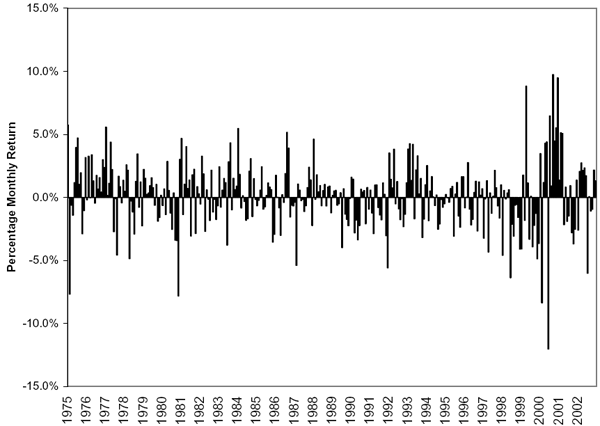Do long-term value investors outperform? In their paper entitled “Do Investors Capture the Value Premium?”, Todd Houge and Tim Loughran seek the answer to this question by examining groups of value and growth equity indexes, mutual funds and individual stocks over long periods. They conclude that:
- There is no evidence of a significant value premium in the returns of style indexes, large-capitalization firms or equity mutual funds.
- During 1975-2002, the S&P 500/Barra value index outperform the S&P 500/Barra growth index by an insignificant 11 basis points per month (see chart below). During 1979-2002, the Russell 3000 value index outperform the Russell 3000 growth index also by an insignificant 11 basis points per month.
- During 1965-2001, large-capitalization value mutual funds return on average 11.4% annually compared to 11.3% for large-capitalization growth mutual funds. During 1965-2001, small-capitalization value mutual funds return on average 14.1% compared to 14.5% for small-capitalization growth mutual funds. Fee differences between value and growth funds do not explain the absence of a value premium.
- Looking at individual stocks rather than funds over 1963-2001, small firms significantly outperform large firms, and value stocks significantly outperform growth stocks.
- Higher fees and the price impact on trading smaller stocks make the value premium unobtainable for the typical mutual fund. In the stock universe practically available to most institutional investors, a value strategy cannot generate abnormal performance.
The authors note as an ancillary finding that the size premium, like the value premium, is not a consistent attribute of equity fund returns.
The following chart, excerpted from the paper, shows the monthly return on S&P 500/Barra value (high book-to-market) minus the monthly return on S&P 500/Barra growth (low book-to-market) during 1975-2002. Overall, neither style wins out, but note the dominance of growth in the late 1990s and the dominance of value in the early 2000s.

In summary, the bid-ask spread, transaction costs and the price impact of trading make the value premium in small-capitalization stocks hard to capture. The prey is generally too elusive for mutual funds and indexes.